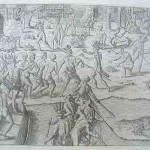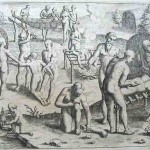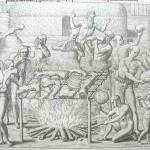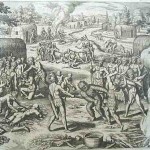Cannibalism is one of the last real taboos of modern society. As such, it evokes a powerful mixture of fascination and revulsion. So strong are these preconceptions, in fact, that both the public and the scientific community have repeatedly fallen prey to them.
“We assume that cannibalism is always an aggressive, barbaric and degrading act,” objects Beth A. Conklin, an associate professor of anthropology at Vanderbilt University. “But that is a serious over-simplification, one that has kept us from realizing that cannibalism can have positive meanings and motives that are not that far from our own experience.”
Conklin’s perspective is based on an intensive study of the Wari’ , a group of native people who live in the Amazon rainforest. Her fieldwork provides detailed confirmation about how and why the Wari’ practiced an elaborate form of cannibalism until the 1960s, when government workers and missionaries forced them to abandon the practice.
“The Wari’ are unusual because they practiced two distinct forms of cannibalism in warfare and funerals ,” Conklin says. “However, the two practices were very different and had very different meanings. Eating enemies was an intentional expression of anger and disdain for the enemy. But at funerals, when they consumed members of their own group who died naturally, it was done out of affection and respect for the dead person and as a way to help survivors cope with their grief.”
Conklin has focused on the less understood practice of funerary cannibalism in her new book, Consuming Grief: Compassionate Cannibalism in an Amazonian Society [University of Texas Press] . “I hope that this book will make people think more deeply about the meanings that the body has in human relationships, and to consider that other cultures may have understood those in ways that made the destruction and transformation of the body through cannibalism seem to be the best, most respectful, most loving way to deal with the death of someone you care about.”
Conklin, who is a medical and cultural anthropologist, began her study of the Wari’ because she was interested in studying how the health and the medical practices of an indigenous population had changed as they came into contact with outsiders who brought new diseases and Western medicine. When she began her research in the 1980s, the Wari’ were being affected by a major international development project in western Brazil but little was known about many aspects of their culture. “At the time, many of my fellow anthropologists didn’t consider the Wari’ very interesting because they had adopted Western clothing, didn’t paint themselves or put on colorful native ceremonies very often and were generally considered to be under the thumb of the missionaries,” Conklin says.
From 1985 to 1987, the anthropologist spent 19 months living in Wari’ communities, plus seven months collecting data at an indigenous health clinic and in national archives. Return trips in 1991, 1999 and 2000 allowed her to confirm her information and interpretations. The case for Wari’ cannibalism is based on the testimony of the Wari’ themselves, corroborated by accounts of missionaries and government officials who said they had witnessed cannibalism at Wari’ funerals in the 1950s and 1960s . Conklin interviewed dozens of older Wari’ who remembered life before contact and talked freely about observing and participating in funerals in which cannibalism was practiced. At about the same time, two Brazilian scientists conducted independent research among the Wari’, producing findings that closely correspond with Conklin’s.
“When I decided to study the Wari’ I was a vegetarian and the last thing I was interested in studying was cannibalism,” Conklin recalls. Her attitude changed as she talked to Wari’ about their experiences with the deaths of family members. To assess changes in patterns of illness and death, Conklin interviewed the heads of 198 Wari’ families and compiled information about when and how their relatives died. Her research documented a history of brutal assaults on the Wari’. Before contact, the Wari’ lived in almost total isolation from other people. They knew of the existence of other Indians and non-Indians, but considered them as “wijam” (outsiders, enemies). They did not trade or intermarry or have peaceful relations with wijam. Their only interactions with outsiders were hostile.
In the 1950s, local businessmen who wanted to open Wari’ lands to commercial development hired assassins, armed them with machine guns and repeating rifles, and sent them out to kill the natives. Whereas Wari’ warriors killed intruders one by one, the assassins massacred entire villages, including many women and children. As a result, more than 25 percent of the deaths that the Wari’ suffered were the result of killings by Brazilians. To stop the escalating violence, the government stepped in.
First in 1956 and then in 1961-62, “pacification teams” went into the forest to leave gifts to attract the Wari’ into peaceful contact. The friendly contact proved to be even more devastating to the Wari’ than the previous hostilities. Due largely to ignorance and carelessness on the part of the government workers, the Wari’ were exposed to infectious diseases to which they had little resistance. The missionaries were much more careful and did what they could to save lives. Nevertheless, the Wari’ died in large numbers and their total population shrank from about 1,000 to 399 within a few years, Conklin says. During the devastating epidemics, the Wari’ became dependent on the government and missionaries for food and medicine. The outsiders used their influence to put a stop to cannibalism and make the Wari’ adopt Western burial practices. Today, all bodies are buried. As Conklin collected family histories of the Wari’, the process led inevitably to the subject of funeral practices. In discussions with older people, she learned that some were uncomfortable with the practice of burial, considering it to be a less respectful and less comforting way to treat the passing of someone you care about.
“In the past, the idea of leaving the body of a loved one in the dirt and letting it rot was as repulsive to the Wari’ as the idea of eating human flesh is to us,” Conklin explains .
As she began exploring these attitudes, Conklin found that the models developed by anthropologists and psychologists to explain cannibalism did not fit. The Wari’ did not eat human flesh because they needed the protein. They were not trying to absorb the dead person’s life force, courage or other qualities. They were not acting out aggression, dominance or a desire to hold onto the deceased. Instead, Conklin concluded that the practice was deeply rooted in the world view of the Wari’ and their understanding of how memories affect the grieving process. Like a number of other groups in South America, the Wari’ have rituals designed to help bereaved relatives cope with their sorrow by eliminating things associated with the dead, which provoke sadness by reminding survivors of their loss and also may attract the dead person’s ghost. To loosen attachments between the living and the dead, Wari’ burn all the dead person’s possessions, including the house he or she lived in. They stop speaking the person’s name and change the appearance of the village and other places where the dead person spent time.
“Consuming the body is part of this process as well,” Conklin says. “Far more than we do, the Wari’ see the body as a place where personality and individuality reside, and so, of all the things that remind you of dead people, the corpse is the strongest reminder. So they believed it was important to transform the corpse in order to help transform survivors’ memories of their dead relative.” This transformation involves developing new images of the dead person joining the animal world. According to their traditional beliefs, the spirits of dead relatives go to an underground world from which they return in the form of wild, pig-like animals called peccaries that are a major source of meat for the Wari’. The ancestor-peccaries seek out hunters from their own families and offer themselves to be shot, ensuring that their meat will go to feed the people they love.
This special relationship with peccaries is part of a native cosmology centered on ideas about communication and transformations between humans and animals. According to Conklin, the traditional mourning rites of the Wari’ emphasized helping survivors to gradually stop dwelling on memories of the past and develop new images of the dead rejuvenated as animals who feed the living. Eating the body at funerals affirmed these positive religious ideas. Reconsidering the range of meanings that consuming substances from the human body had for people in the past is important, Conklin says, because it challenges the negative stereotypes of cannibalism that have often been used to denigrate and stigmatize native peoples. “Thinking about cannibalism as a way to cope with grief and mourning gives it a more human-even humane-face,” Conklin says. Such reconsideration can also make us reflect on our own ways of dealing with death.
“Wari’ recognize the intensity of bereavement, whereas the tendency these days is to resist even the thought of death. In modern society, there is no longer a standard way of dealing with death and I think something has been lost. As a result, we are very uncomfortable dealing with bereavement,” Conklin says. “We feel pressure to hide our grief; we don’t know how to treat people who have suffered a loss. There is a certain wisdom in the Wari’ practice of acknowledging the deep impact of death and survivors’ need for social and spiritual support.” To us, cannibalism looks like an extreme, exotic practice. “By stepping outside our own cultural framework to try to understand this from the Wari’ point of view, however, we can see some of the realities of social life, especially the ways of caring and coping, that unite us all as human beings,” she says.
- nice girl
- sick
- horror
- cannibals
- cooking
- meat









incredible detail in your pictures
Could hardly have come at a better time. Terrific piece of writing.
Thank you for give very nice informations. Your web is goodI am impressed by the information that you have on this blog. It shows how well you understand this subject. Bookmarked this page, will come back for more. You, my friend, ROCK! I found just the information I already searched everywhere and just couldn’t find. What a perfect site. Like this website your website is one of my new favs.I like this data given and it has given me some sort of inspiration to succeed for some reason, so thanks
I have read about adoption extensively. I would like to adopt a school-aged child with HIV. Part of me feels very guilty because of the expense involved in international adoption. We could swing it, but I feel like I am letting down my mom, who might need financial support in the future. I feel like I am being selfish. But, it is my money, right?
Fabulous This really is one of the best web sites I’ve ever read on this subject.